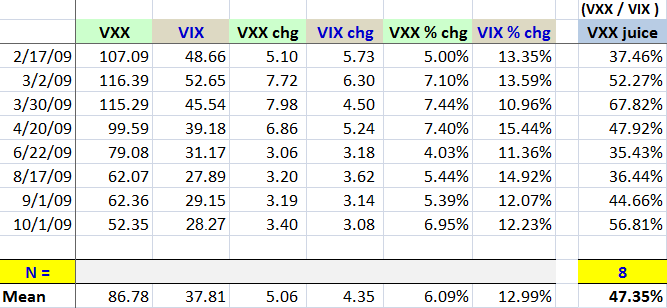Why VXX Is Not a Good Short-Term or Long-Term Play
During the last month, the iPath S&P 500 VIX Short-Term Futures ETN (VXX) has been turning over an average of 1.3 million shares per day. I am certain that a fair portion of the purchases of VXX have come from investors who have sought to protect their portfolios from an increase in volatility and/or downturn in stocks.
Unfortunately, VXX has considerable shortcomings, both as a short-term and a long-term play.
Investors who are long VXX hope that when volatility increases dramatically, they will benefit by holding the short-term VIX ETN. In fact, when the VIX spikes 10% or more in one day, VXX generally does not cover even half of that move in percentage terms. The table below shows the eight instances since the January launch of VXX in which the VIX rose 10% or more in one day. The results speak for themselves, but in the eight instances over the course of eight months, VXX has been capturing only one third to two thirds of the VIX spike.
Ironically, when the VIX is flat or falls, VXX does a much better job of keeping pace. The VXX juice factor (VXX movement as a percentage of VIX movement) shows just how disappointing the performance of VXX relative to the VIX is when the VIX spikes. The bottom line is that when you need it most, VXX is at its worst in tracking the VIX.

VXX may be even less effective as a long-term holding. As previously discussed in VXX Calculations, VIX Futures and Time Decay, VXX suffers from negative roll yield when the VIX is in contango (when the front month VIX futures are less expensive than the second month futures), with the result that VXX loses a few cents each day due to rebalancing, just like a tire with a slow leak. This is why VXX is not able to sustain its value the way the VIX does. Today, for instance, the VIX closed at 28.27 and VXX closed at 52.35. Back on June 9th, the VIX also closed at 28.28, yet on that day VXX closed at 74.26. That 29.5% drop in VXX while the VIX held steady is largely the result of negative roll yield – and is evidence that VXX is usually not viable as a long-term holding.
I have discussed the movements of VXX in considerable detail in my subscriber newsletter, but for those who are interested in more information about VXX on the blog, some related posts include:

